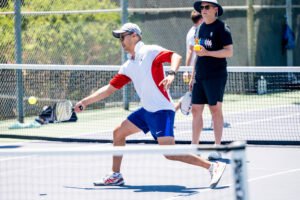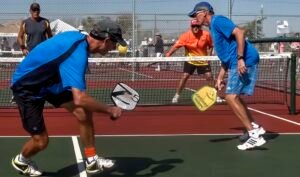Picture this: the sun is shining down on the perfectly manicured courts, the gentle breeze carries the sound of laughter, and you stand at the ready, paddle in hand, heart pounding with anticipation. It’s game time, and you know that victory hinges not only on your skill and determination, but also on your ability to decode the strategies of your opponents. Welcome, pickleball enthusiasts, to the world of scouting your competition. In this tactical guide, we will dive into the intricacies of understanding your adversaries on the court, unraveling their playing styles, and equipping you with the knowledge to outsmart and outplay them. Whether you’re a seasoned player seeking an edge or a rookie hungry to prove yourself, get ready to elevate your game as we delve into the secrets of how to effectively scout your pickleball competition.
Table of Contents
- Introduction: Understanding the Importance of Scouting Your Pickleball Competition
- Analyzing Player Styles: Observing Techniques, Strategies, and Weaknesses
- Identifying Strengths and Weaknesses: Evaluating Technical Proficiency and Tactical Decision-Making
- Strategizing for Success: Tailoring Your Game Plan to Exploit Weaknesses and Capitalize on Opportunities
- Mastering the Mental Game: Uncovering Psychological Patterns and Habits
- Q&A
- Future Outlook

Introduction: Understanding the Importance of Scouting Your Pickleball Competition
In the exhilarating world of pickleball, understanding the importance of scouting your competition can be the key to unlocking your true potential on the court. As players from all walks of life come together to engage in this thrilling sport, knowing your opponents’ strengths and weaknesses can give you a significant advantage. By analyzing their playing style, strategic choices, and overall approach, you can strategize, adapt, and counter their moves effectively.
Scouting your pickleball competition allows you to enter matches armed with valuable insights. Start by observing their preferred shot selections, whether they favor powerful smashes or tap into their agility with subtle dinks. Take note of their strengths, such as their incredible speed, unyielding accuracy, or outstanding court coverage. Identify their weaknesses in return, whether it’s a weaker backhand or struggling under pressure. This knowledge empowers you to create a game plan that capitalizes on your opponent’s vulnerabilities and maximizes your own strengths.
Furthermore, scouting not only provides a tactical advantage but also fosters a deeper appreciation for the sport. By studying the techniques and strategies employed by other players, you can gain valuable insights into the ever-evolving nature of pickleball. Learning from your competitors, adapting your tactics, and honing your skills based on their performance is an essential step towards becoming a well-rounded player. So, lace up your shoes, grab your paddle, and embark on the thrilling journey of scouting your pickleball competition!

Analyzing Player Styles: Observing Techniques, Strategies, and Weaknesses
When it comes to analyzing player styles, there is no shortage of techniques, strategies, and weaknesses to observe. Each player brings their own unique set of skills and playing style to the field, making every match an opportunity for analysis and insight.
One technique that stands out is the ability to quickly adapt to different game situations. Some players excel at reading the game, anticipating plays, and making split-second decisions. These players have a strategic mindset and can effectively execute various strategies to gain the upper hand. Whether they are an attacker or a defender, their awareness and decision-making skills set them apart from the rest.
On the other hand, weaknesses can also be identified during analysis. Some players may struggle with specific techniques, such as aerial duels, ball control, or passing accuracy. These weaknesses can be exploited by opponents who have done their homework. Understanding an opponent’s weak areas can provide valuable insights that can be used to devise effective strategies and game plans.
Observing player styles is an essential aspect of any coach or analyst’s job. By carefully analyzing techniques, strategies, and weaknesses, valuable knowledge can be gained that can be used to improve performance both individually and as a team. Whether it’s fine-tuning a player’s strengths or devising tactics to exploit an opponent’s weaknesses, the analysis of player styles plays a crucial role in the development and success of any team.

Identifying Strengths and Weaknesses: Evaluating Technical Proficiency and Tactical Decision-Making
When assessing an individual’s abilities in technical proficiency and tactical decision-making, it is crucial to delve deep into their skillset and mindset. By identifying their strengths and weaknesses in these areas, we gain invaluable insights that can lead to targeted improvement and enhanced performance.
Technical Proficiency:
- Expertise in Specific Tools: Evaluate the individual’s proficiency with the tools and technologies relevant to their field. Look for command over programming languages, software applications, and hardware components. Identify specific strengths, such as advanced troubleshooting skills or creative problem-solving abilities.
- Adaptability and Learning Potential: Assess how quickly they can adapt to new technologies and processes. Can they learn and apply new skills efficiently? This demonstrates their ability to stay up-to-date in the face of ever-changing technological landscapes.
- Attention to Detail: Analyze their ability to pay close attention to technical details. Individuals with a keen eye for detail tend to produce more accurate and reliable work, reducing the risk of errors and improving overall quality.
Tactical Decision-Making:
- Strategic Thinking: Evaluate their ability to see the big picture and think strategically. Do they possess the foresight to anticipate potential challenges and proactively develop solutions? Exceptional strategic thinking often leads to improved project planning and execution.
- Problem Analysis and Resolution: Analyze their approach to problem-solving. How do they identify and analyze problems? Do they rely on past experiences or take a more data-driven approach? Individuals who can break down complex issues and find innovative solutions exhibit strong decision-making skills.
- Time Management: Assess their ability to prioritize tasks efficiently and meet deadlines. Strong tactical decision-makers can manage their time effectively, ensuring important tasks are completed in a timely manner, and avoiding unnecessary delays or bottlenecks.
By thoroughly assessing an individual’s technical proficiency and tactical decision-making, we gain a comprehensive understanding of their strengths and weaknesses. Armed with this knowledge, we can tailor training programs, assignments, and mentorship opportunities to further develop their talents and address any areas that require improvement.
Strategizing for Success: Tailoring Your Game Plan to Exploit Weaknesses and Capitalize on Opportunities
In the world of business, strategizing is crucial. It is not merely enough to have a plan in place, but to tailor that plan to exploit weaknesses and capitalize on opportunities is where true success lies. By doing so, you can gain a competitive edge and achieve your goals more effectively.
One of the first steps in tailoring your game plan is identifying the weaknesses of your competitors or the market itself. This requires careful analysis and research. Make a list of the areas where your competitors are lacking or where the market is underserved. Remember, weaknesses represent opportunities for growth and improvement.
Once you have identified the weaknesses, it’s time to turn them into your strengths. Devise a strategy that focuses on addressing these weaknesses head-on. It could involve developing new products or services to fill the gaps, improving customer service, or enhancing the quality of your offerings. Remember to remain flexible and open to adapting your plan as needed.
On the flip side, identifying and capitalizing on opportunities is equally important. Keep a close eye on market trends, emerging technologies, and changes in customer preferences. This will allow you to spot opportunities before your competitors do. Perhaps there’s a new market segment that you can target, or a partnership opportunity that could greatly benefit your business. Whatever it may be, be proactive and take the necessary steps to seize these opportunities.
Remember, strategizing for success is an ongoing process. Regularly reassess your game plan, monitor industry trends, and stay updated with the changing dynamics of your target market. By continually tailoring your strategies to exploit weaknesses and capitalize on opportunities, you position yourself for long-term success and growth.
Mastering the Mental Game: Uncovering Psychological Patterns and Habits
Delving into the intricate realm of the mind, Mastering the Mental Game takes you on a transformative journey of self-discovery. As we explore the depths of our psychological patterns and habits, we gain invaluable insights into the inner workings of our minds.
Uncovering these patterns requires a keen eye for detail and a willingness to introspect. By examining our thoughts, emotions, and behaviors, we unearth the hidden threads that shape our mental landscape. Self-reflection becomes a powerful tool in this process, enabling us to identify recurring patterns that propel us towards positive outcomes or hinder our growth.
Throughout this journey, it is essential to maintain a neutral mindset, free from judgment or self-criticism. Understanding that every pattern and habit serves a purpose, whether adaptive or maladaptive, allows us to appreciate the complexity of our mental makeup. Armed with this knowledge, we can actively work towards breaking free from negative patterns and cultivating healthier habits that align with our goals and aspirations.
- When exploring psychological patterns, remember:
- Observe your thoughts and emotions objectively.
- Look for commonalities and recurring themes in your behaviors.
- Consider the underlying motivations behind your actions.
- Be patient with yourself throughout the process.
- To uncover habits, try the following:
- Identify routines that lead to desired outcomes.
- Recognize habits that may be holding you back.
- Create a plan to replace negative habits with positive alternatives.
- Seek support or guidance when necessary.
As we gain a deeper understanding of our psychological landscape and work towards transforming detrimental patterns into empowering habits, we unlock the potential for personal growth and enhanced well-being. Let’s embark on this journey together, uncovering the mysteries of our minds, and mastering the mental game.
Q&A
How can I effectively scout my pickleball competition?
To scout your pickleball competition effectively, begin by researching their playing style, strengths, and weaknesses. Watch previous games they have played and take note of their strategies and patterns. This will enable you to develop a tactical plan to counter their gameplay.
Is it important to understand my opponents’ strengths and weaknesses?
Understanding your opponents’ strengths and weaknesses is vital in pickleball. By recognizing their strengths, you can anticipate their moves and develop effective counter-strategies. Similarly, identifying their weaknesses allows you to exploit those areas during the game.
What should I look for while watching my opponents’ previous games?
While watching previous games of your opponents, pay attention to their shot selection, court positioning, and overall game strategy. Look for patterns, tendencies, and any areas of vulnerability that you can exploit. This will help you adapt your own game plan accordingly.
How can I gather information about my competition?
To gather information about your competition, you can consult pickleball forums, follow their social media accounts, or even seek insights from players who have faced them before. Attending tournaments or watching their matches live can also provide valuable information about their playing style.
Should I focus only on studying my most challenging opponents?
While it is essential to prioritize studying your most challenging opponents, it is also crucial to gather information on all your competitors. Your analysis should include both harder and easier opponents, as understanding the strengths and weaknesses of all players will enhance your overall strategic approach.
What should I do with the information I gather about my competition?
Once you have gathered information about your competition, analyze and integrate it into your own game plan. Identify their vulnerabilities and develop strategies that exploit them while leveraging your own strengths. Practicing these strategies will increase your chances of success on the pickleball court.
Future Outlook
As the final whistle blows and the spectators applaud, it’s time to wrap up our tactical journey through the world of pickleball scouting. We’ve explored every angle, delved into the darkest corners of the opponent’s game, and armed ourselves with the knowledge needed to outsmart and outplay our rivals.
From the moment we step onto the court, an air of curiosity fills our minds. Who are these adversaries? What strategies do they employ? What weaknesses can we exploit? Now, armed with our tactical guide, we know where to begin our quest for victory.
Pickleball scouting is a craft, a dance between analysis and strategy, where every action on the court is meticulously calculated. It demands a keen eye, an open mind, and an insatiable thirst for knowledge. It’s the art of unraveling mysteries, of connecting the dots that lead us to triumph.
In the realms of pickleball, the competition is fierce, and only the well-prepared prevail. Our guide has equipped us with a diverse array of tools. From observing body language to deciphering playing styles, from analyzing shot selection to unmasking the concealed patterns, we have been honing our skills to exploit every chink in the opponent’s armor.
But let us not forget that there’s more to the game than charts, graphs, and statistics. Beyond the numbers lies the beauty of the sport, where the unpredictable reigns supreme. It is in those moments, where instinct and adaptability collide, that true mastery is revealed.
So, my fellow pickleball enthusiasts, take these tactics, these insights, and make them your own. Transform them into an extension of your game, and allow them to guide you on the path to greatness. But always remember that while scouting your competition is essential, it is your passion, dedication, and love for the sport that truly sets you apart.
As we bid farewell to this tactical guide, let us embark upon the courts with renewed vigor, armed with the knowledge needed to navigate the treacherous waters of pickleball rivalry. Go forth, fellow players, and embrace the challenge head-on. For in the game of pickleball, victory is the sweetest when earned through unyielding effort, strategic brilliance, and an unwavering commitment to the craft.
As an affiliate, my content may feature links to products I personally use and recommend. By taking action, like subscribing or making a purchase, you’ll be supporting my work and fueling my taco cravings at the same time. Win-win, right?
Want to read more? Check out our Affiliate Disclosure page.




